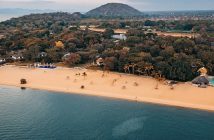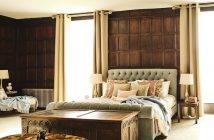Every New Year, people make promises to themselves – give up smoking, join the gym, lose weight. Same old, same old. So this January I thought I’d write about a quite different approach, something that’s new to most people but also just about as old as it gets when it comes to health.
Classical Chinese Medicine (CCM) was almost completely established by the Han period (somewhere between the 2nd century BC and the 2nd century AD). It shouldn’t be confused with Traditional Chinese Medicine (TCM), a simplified form that was introduced by the Maoist regime after the cultural revolution. CCM takes into account the seasons and climate, emotions and diet, sleep and exercise, childhood illnesses, environment and work – just about everything, really – and looks at their combined impact on the three fundamental substances of the body: the Jing (vital principle), the Qi (energy or breath) and the Shen (the spirit). These three are themselves related to particular organs or parts of the body. Qi is located in the lungs and represents vitality. Shen dwells in the heart and regulates all the body’s activities. Jing is everywhere but predominantly in the kidneys and is particularly affected by prolonged stress.
So while in CCM, the human body has the same organs, performing the same functions as they do in western medicine, those organs also have an energetic quality. According to the Chinese tradition, energy runs through a system of meridians that course through the body (somewhat similar to the nervous system). That energy flow can, though, be altered by any of the factors mentioned above – and that, in turn, creates new problems. Take emotions. Anger affects the liver and that will result in headaches, tight muscles in the neck and shoulders, smarting red eyes. Or there again, take diet. CCM focuses particularly on flavours and every flavour nourishes a particular organ (sour for liver, bitter for heart, sweet for spleen, tangy for lung, savoury for kidneys). However, if you take too much of any one flavour, you will actually damage the related organ. If there’s one underlying tenet in CCM, it’s balance in all things. And restoring that balance is the ultimate aim of CCM.

It is also the aim of the multi-award-winning Lefay Spa that sits high on the hills above Lake Garda, surrounded by olive and lemon groves. It is a remarkably beautiful spot and has been created with the idea of preserving that natural beauty on every level. They have the highest eco-sustainability credentials with their own biomass plant that produces 70% of the resort’s thermal energy and photovoltaic panels that produce 60% of its electricity and their water saving and waste management have equally impressive stats. So you know you’re somewhere that cares about the environment – which makes sense given the importance of the environment in CCM.
Lefay is a very unusual place and has created its own blend of the western and the oriental. The Lefay Spa Method uses CCM as its underlying principle, so you begin with a consultation with a doctor who analyses your energy levels. I had filled in a questionnaire about my family and my own medical history, my diet and lifestyle. The doctor took this further asking about my sleep patterns and my dreams, my prevailing mood over the last year and recent events in my life, even about my birth – CCM takes the long view. She also took my pulses (both wrists at three varying depths) and came up with a diagnosis of my energy levels and a plan to bring me into better balance. I was tired, she said, after a period of prolonged stress and this affects the kidneys.
As a result of this (and several other factors), she prescribed the “Black Turtle” programme. I’d better explain this. The Lefay Method is divided into four “seasons” of treatments. Each relates to both a particular health and energetic profile as well as to a time of year and even a time of day. So, the Green Dragon is morning, springtime and a time of rising energy. Red Phoenix is midday, summer, the strongest energy. White Tiger is sunset, autumn and falling energy. And that leaves the Black Turtle – midnight, winter and a time when energy withdraws deep into the body to recuperate. Each season is reflected in a particular garden sited around the resort devoted to a particular energy, a place for specific types of exercise (Tai Chi, yoga etc) or reflection and meditation.

With my diagnosis sorted, the doctor changed my provisional timetable. Hydro-aromatherapy became moxibustion to address the energy imbalance of the kidneys. Moxibustion uses a dried version of the mugwort plant and burns it above particular acupressure points. Before we began, my therapist Marco showed me what resembled black crayons. These would be heated to 650 degrees and held just above a series of points that connected with the kidneys. “Don’t worry,” he smiled, “they won’t touch your skin.” It was still pretty hot. This would, though, he promised, stimulate my energy and also protect another two weak points (spleen and lungs). I was also somewhat stimulated – not to say surprised – by another factor. During the moxibustion and the massage that followed, the background music was not the usual floaty spa themes. It was Wagner. As prescribed by the doctor, I had 90 minutes of stirring orchestral music (no singing). So no chance of dropping off to restore that depleted energy but, then, I do like Wagner. It was a good massage, too, on a heated table with very hot oil scented with geranium (my other choices, again prescribed, were juniper or basil) and long gentle strokes interspersed with strong pressure on particular related acupressure points.
Later that afternoon, I had another prescribed session – stretching of the meridians, again aimed at improving my energy flow. This is a bit like Qi Gong, and a bit like yoga and is designed to go through every major meridian in the body, rebalancing organs and energy through held postures and stretches. If you did it every day, I was told, it’s the perfect way to rebalance your energy. I took the yoga class a little later, too – no doubt an unconscious attempt to justify what turned out to be a fantastic dinner. This may be a spa but it is also Italy and food here is meant to be a pleasure. There are two restaurants at Lefay – the fine dining La Grande Limone and the more rustic Italian, Trattoria La Vigna.

Both restaurants, though, focus on healthy food. So it’s not surprisingly based on the local Mediterranean diet, with plenty of extra virgin olive oil, local products (lemons, truffles, perch from the lake), organic and seasonal foods. There’s a special spa menu that’s slightly lighter but, to be honest, everything is super healthy and fresh. Feeling particularly virtuous, I had “Il Giardino” as a first course – crunchy, barely cooked organic vegetables with olive oil. Mains include home-made pasta, fish, chicken and kid (delicious) but the portions are small and manageable so there’s room for a treat at the end (rhubarb ice cream, sensational). The presentation and service are faultless. The breakfasts are good, too, and you can be as virtuous or gluttonous as you like as it’s all buffet. Cold meats and salads, fruit and yoghurt, vast quantities of cakes and pastries and a stack of fresh organic vegetables and a juicer for you to make your own juice.
The spa has a very wide range, too, and the Lefay Method has some unique treatments where it has combined beauty and acupuncture. Fine needles stimulate collagen and the blood flow to the face to keep the skin tight and supple. There are other points on the stomach that increase the nutritional value of food to improve the skin texture and keep it moisturised. After the needles, the massage: this drains lymph build-ups and remodels the face and neck muscles – they promise results after just one treatment. Then there are slimming treatments, reflexology, tui na massage, body scrubs, Turkish baths and flotation.

I spend a leisurely morning, doing aquagym, then swimming in the indoor/outdoor pool (a sensor opens the water gates as you swim up), and lounging in the Turkish bath (no swimsuits but pareos provided). So I was feeling much more relaxed when it was time for my “Massage of the Centre” which turned out to be an facial massage. The emphasis here is on massage rather than facial. In fact, it started with a pressure point massage first on my fingertips and arms, then on my toes, again the points all prescribed by the doctor in advance. By the time it got to my face I was on the brink of falling asleep but it was too delicious to miss and I managed to stay awake (no Wagner today). Lemon scented oil was massaged in little circles and I felt my face softening under the gentle pressure. The massage was all of the face and scalp – even my eyelids, nose and above my top lip. It’s amazing where you can store tension. By the end I was floating and yet totally still and centred. The doctor said I needed more relaxation. This certainly does the trick.
The Lefay Spa Essence programme costs £815 (Euros1095) per person for three nights based on two people sharing. The price includes breakfast, lunch and dinner, all the treatments of the Lefay Spa Method Essence programme, use of the pools and sauna and herbal teas during the day. The resort closes for January and re-opens next month. For more information, visit www.lefayresorts.com or call +39 0365 214800.
EasyJet flies from Gatwick to Verona daily with prices starting from £30.24 per person (one-way, including taxes and based on two people on the same booking). All flights can be booked at www.easyjet.com.




